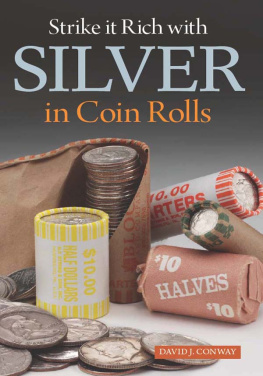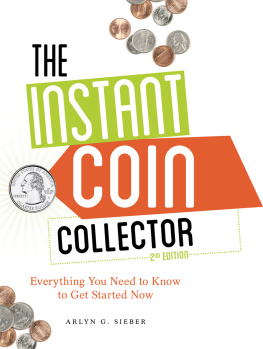Warmans
COINS
AND
PAPER
MONEY
5TH EDITION
BASED ON THE ORIGINAL WORK OF ALLEN G. BERMAN
IDENTIFICATION AND PRICE GUIDE
ARLYN G. SIEBER
INTRODUCTION
T hanks to Bi Sheng for his role in helping to create this new edition of Warman's Coins and Paper Money. Bi Sheng (also spelled Pi Sheng in some translations) was an 11th century Chinese commoner who invented movable type. His invention opened the door to modern printing, which made books and other publications available to the masses. Bi Sheng is also the subject of at least two commemorative coins --- a 1988 5-yuan coin issued by China and a 1995 crown issued by the Isle of Man.
Bi Sheng is just one of many important and interesting historical figures readers will meet in the pages that follow. They will also learn about important historical events, other important historical inventions, unique cultural aspects of the countries covered, and economic history. Collecting the coins documented in this book provides a virtual history of a country or, when collecting across multiple countries, a virtual history of the world.
This fifth edition of Warman's Coins and Paper Money has been extensively revamped from the previous edition. It now covers the most popularly collected eras of the most popularly collected countries. Extensive U.S. and Canadian listings have been carried over and updated from the previous edition. Also, listings for Great Britain and Mexico have been expanded and updated. Listings for other countries have also been expanded, providing a more extensive overview of what is available to collect from the selected countries.
HOW TO COLLECT COINS
A coin collection can be whatever an individual wants it to be. Collect what you like and what brings you pleasure as a leisure-time hobby. It's also good to have a strategy and a road map to your collecting pursuits. Thus, following are some tips and comments on traditional collecting strategies.
By series. The traditional coin-collecting pursuit of acquiring one example of each date and mintmark within a particular series may seem daunting at first considering the vast scope of world coins. Some denominations and designs within those denominations span several decades or even a century or more.
To get started, a collector can break down a series into smaller parts. For example, a collector interested in Lincoln cents can start with those depicting the Lincoln Memorial on the reverse, which begin in 1959. A collector can also get started by collecting simply one date of each Lincoln Memorial cent rather than seeking an example of every mintmark of a particular date.
By type. Rather than seeking an example of every date and mintmark within a series, many collectors seek just one example of each type of coin within a particular focus. For example, a collector assembling a 20th century type set of U.S. 5-cent coins would seek one Liberty nickel, one Buffalo nickel, and one Jefferson nickel. The representative coins could be of any date and mintmark within each series, thus accommodating any collecting budget.
By country. Collectors sometimes focus on coins of a particular country because of some emotional nexus with that land. It may have been their ancestors' homeland, or they may simply like the coin designs and history of a particular country.
By region. A coin collection can also focus on a particular continent or geographic region, such as Europe, the Middle East, or Southeast Asia.
By empire. A coin collection can be a virtual history book of an empire. It can document the dates of an empire's rise to power, the reigns of monarchs, and changes in political entities.
By era. Some collectors focus on coins of a particular era. It could be a certain century or decade, the reign of a certain monarch, an era with personal significance to a collector, or an important historical time.
One per country. Another common collecting strategy is to acquire one example of the coinage of as many countries as possible. Narrowing the focus here could include a particular geographic region, century, or era.
By theme. The proliferation of modern commemorative and circulating commemorative coins gave rise to collecting coins with a common theme. Examples include coins that depict animals or ships, coins from one or more countries that commemorate a certain event, or coins of a certain date, such as 2000.
By collector's choice. Various aspects of the listed strategies overlap and can be combined and mixed to form a goal that interests an individual collector. The result should be a coin collection that is affordable and attainable for the collector, and a collection that brings enjoyment and satisfaction.
HOW TO HANDLE COINS
The less coins are handled, the better. Dirty, oily hands --- even if they appear to be clean --- lead to dirty, oily coins. Oftentimes, however, coins have to be handled, particularly when searching circulating coins or when transferring a coin to a holder. When it is necessary to handle a coin, it should be held by the edges between the thumb and forefinger. Avoid contact with the coin's obverse and reverse surfaces.
Also, handle coins over a soft surface so they will not be damaged if accidentally dropped.

Should I clean my coins? No.
Luster is an important aspect when grading certain high-end coins, but in general, a coin's grade and its corresponding value depend on the amount of wear on the coin, not how shiny it is. Cleaning --- particularly home-brewed methods --- is often abrasive and will damage a coin rather than improve it.
There may be certain instances when it is desirable to clean a coin, but that is best left to experienced opinions as to when and how.
HOW TO STORE COINS
Folders. Cardboard folders are the most inexpensive and common form of organizing and storing a collection. They can be purchased at many hobby shops and bookstores.
They provide a spot for each date and mintmark in a particular series, thus acting as a road map for the collector. They are also compact and convenient; they take up little space on a bookshelf and can be pulled down and opened for easy viewing.

The spots for the coins consist of holes in the cardboard sized specially for the particular series covered by the folder. They are meant to be a tight fit so the coins, once inserted, won't fall out. Place the coin in the hole at an angle, so one side of the coin is in the hole. On the side of the coin sticking up, press down and toward the angled side until the coin snaps into place.
The process isn't always graceful; thus, some of the basic rules for handling coins have to be suspended when working with folders. But folders are still suitable for storing coins plucked from circulation and getting started in coin collecting.

2-by-2s. Low to moderately priced coins offered for sale at shops and shows are usually stored in cardboard holders commonly called "2-by-2s" because they are 2 inches square. They consist of two pieces with a clear Mylar window in the center. The coin is placed between the two pieces, which are then stapled together.
















